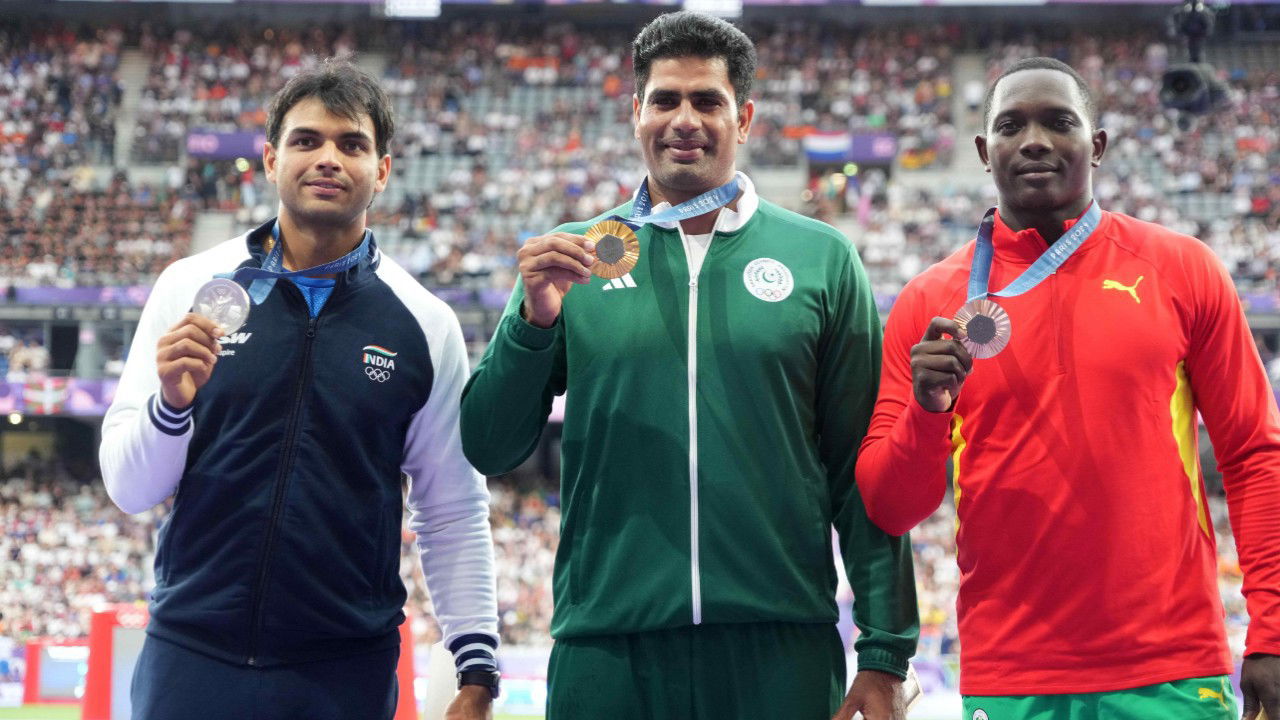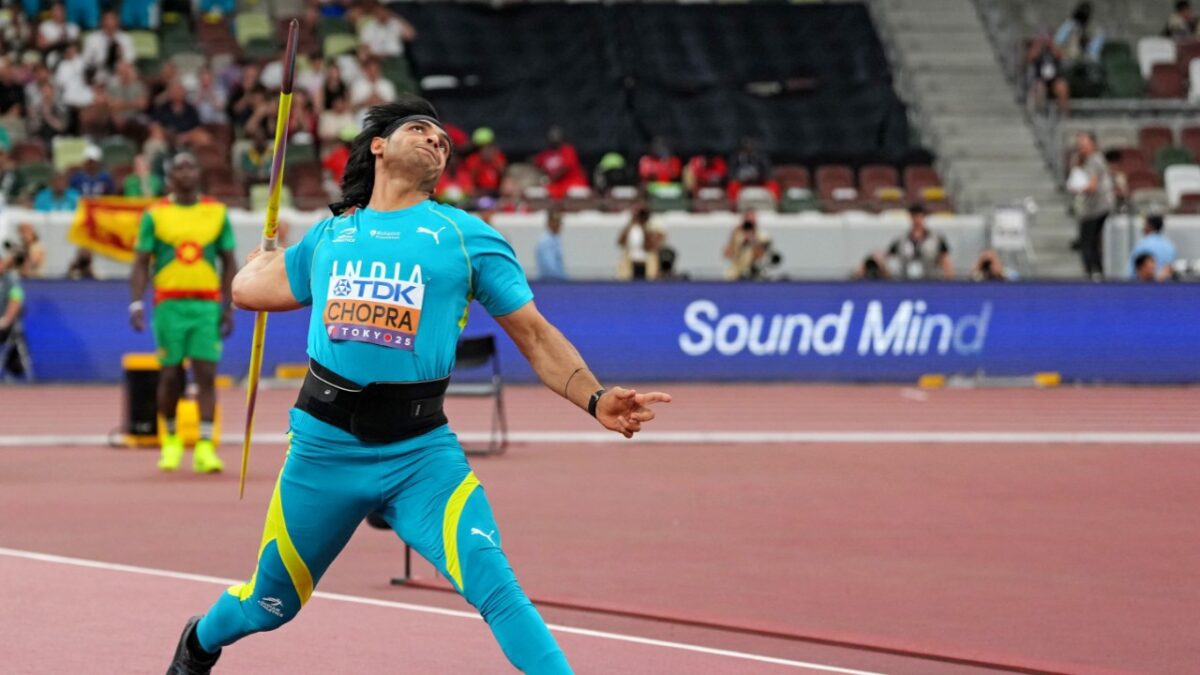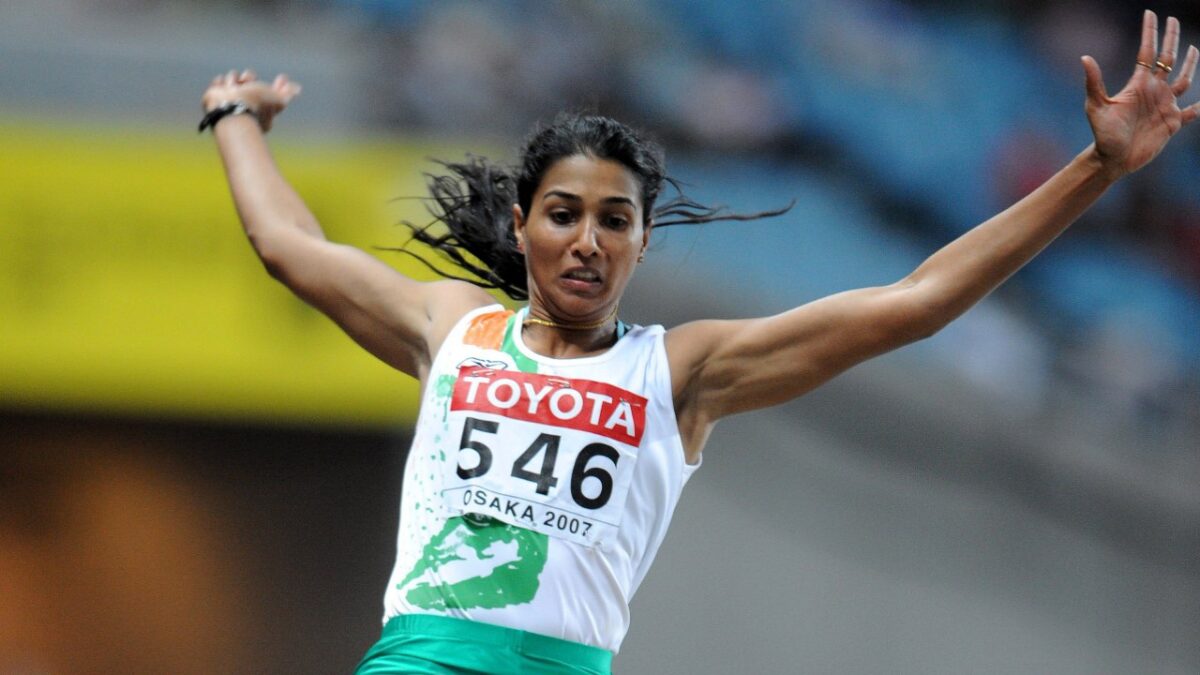Why India Should Demand More Transparency from AIU Regarding Arshad Nadeem?
In a bid to safeguard its interests, India should take strong stops to get the full picture of Arshad Nadeem's Olympic triumph.

Arshad Nadeem and Neeraj Chopra at the Olympics (via Imagn)
🔍 Explore this post with:
The 2025 World Athletics Championships concluded in September, and the Men’s Javelin Throw proved disappointing for fans from the Indian subcontinent. Sachin Yadav finished an agonizing fourth, while Olympic champions Arshad Nadeem and Neeraj Chopra fell short of the podium.
For Yadav, it was still a promising debut season on the international stage. But for Chopra, it marked a rare setback, the first time in 26 consecutive competitions since 2021 that he failed to place in the top two.
Arshad Nadeem’s Competition Record
Arshad Nadeem has participated in around 25 competitions throughout his career since debuting in 2015, including both international and domestic events. Typically, an elite javelin thrower competes in 5–10 tournaments per year, spanning the World Championships, Olympics, Diamond League, Continental Tour, and various domestic meets.
For comparison, between the Tokyo 2021 and Paris 2024 Olympics, most Olympic medal contenders in men’s javelin took part in at least 15 events, with some competing in as many as 40 during that Olympic cycle.
Nadeem, however, only appeared in six events during that same period, one of which was a domestic competition.
- In 2023, he competed in just one event, which was the World Championships in August.
- His next appearance came almost a year later, at his Diamond League debut in July 2024, followed by the Paris Olympics in August, where he won gold with a record-breaking throw of 92.97m.
A similar pattern emerged between 2021 and 2022. After finishing fifth at the Tokyo Olympics, Nadeem next competed at the World Championships in July 2022, then claimed gold at the Commonwealth Games in August 2022 with a throw of 90.18m.
Following that, he remained absent from competition until August 2023. Looking further back, between Rio 2016 and Tokyo 2021, Nadeem took part in only 11 competitions, including three domestic events.
Nadeem During 2022–2024: A Case of Narrative Spin?
A curious media narrative has surrounded Arshad Nadeem’s journey over the past few years, one that portrays him as a struggling underdog lacking basic support. However, a closer look at the facts paints a very different picture.
After receiving an International Olympic Scholarship in 2022, one might have expected Nadeem to compete more frequently during the 2021–2024 Olympic cycle. Instead, his participation remained limited, and much of that time was attributed to injuries and recovery. Here is a list of events from this career between December 2022 and August 2024.
- December 2022: Nadeem underwent elbow and knee surgery in England.
- June 2023: A left knee injury ruled him out of the Asian Athletics Championships.
- August 2023: He returned impressively to win silver at the World Championships with a throw of 87.82m, showing excellent rehabilitation progress.
- September–October 2023: He withdrew from the Asian Games, again citing knee issues.
- February 2024: Nadeem had another knee surgery in England.
- March 2024: He claimed that a lack of an international-standard javelin was limiting his training and competition readiness.
- August 2024: He made a stunning comeback, winning Olympic Gold with two throws over 90m.
World-Class Training and Support for the Pakistani Medalist
Since at least March 2022, Nadeem has trained in South Africa under Terseus Liebenberg, one of the world’s leading javelin coaches. He has also had consistent access to elite medical and recovery facilities, including multiple surgeries in the UK.
If Nadeem, his team, and his federation could organize and afford access to world-class coaches and top-tier sports medicine experts, the very support that helped him achieve 90m+ throws despite serious injuries, it seems puzzling that he was reportedly unable to obtain something as basic as a competition-grade javelin in early 2024.

Given that he had earned $35,000 in prize money for his World Championships silver medal, one would imagine that buying a new javelin would have been among his priorities. Even Neeraj Chopra expressed surprise at this claim.
It is also worth noting that Nadeem was sent to China for training as early as December 2019–January 2020, just before the COVID-19 outbreak, evidence that his federation had been investing in his development long before his global breakthrough.
Taken together, the facts suggest that much of the “struggling underdog” narrative surrounding Nadeem during 2022–2024 may have been overstated. He received world-class coaching, medical care, and strategic workload management, factors that contributed to his remarkable success despite limited competition appearances.
Rather than a story of neglect, Nadeem’s journey reflects careful planning and elite-level support. The popular focus on his supposed hardships, or his friendly rivalry with Chopra, often overshadowed the more compelling story of how an athlete from a non-traditional athletics nation rose rapidly to the world stage.
This raises a key question: Was Nadeem’s public image during this period shaped more by narrative-building than by reality?
Why Anti-Doping Comes Into the Picture?
Several publicly available facts raise questions about anti-doping oversight in relation to Arshad Nadeem’s career:
- Limited competition record: Nadeem has competed in a surprisingly small number of events throughout his career compared to other elite javelin throwers.
- Statistical outlier: No other world-class thrower has had such an unusual competition pattern, both in terms of frequency and consistency.
- Pakistan’s anti-doping record: Pakistan’s National Anti-Doping Organization (ADOP) was placed on a WADA watchlist in September 2024 for irregularities. It was removed in September 2025, but this means Nadeem’s peak competitive period (2022–2024) overlapped with a time when ADOP’s credibility was in question.
- AIU testing pool inclusion: Since 2022, Nadeem has been part of the Athletics Integrity Unit (AIU) Registered Testing Pool (RTP), which requires at least three Out-of-Competition (OOC) tests per year.
- Lack of transparency: The AIU’s publicly available data does not mention Pakistan among the 43 National Olympic Committees (NOCs) listed for OOC testing ahead of the 2024 Olympics.
- Missing records: Similarly, Pakistan is absent from the public testing lists for the lead-up to the 2022 and 2023 World Championships, leaving uncertainty around how many OOC tests Nadeem underwent.
- Fewer in-competition tests: Because Nadeem competed so rarely between 2022 and 2024, he would have been subjected to fewer in-competition (IC) tests than his international rivals. This makes OOC testing crucial, yet there is no clear data confirming how often it is done.
- Low-priority status: Pakistan’s Athletics Federation (AFP) is classified as Category C by the AIU, meaning it is considered low risk and thus receives less anti-doping scrutiny than Category A nations like Kenya or the U.S.
- Security challenges: Countries such as the US, UK, and Canada have long-standing travel advisories for Pakistan, making certain regions (particularly Baluchistan) difficult to access for foreign testing officials.
- Precedent of doping cases: Pakistani weightlifter Talha Talib, who gained fame after the 2021 Olympics, tested positive for banned substances in 2022 following OOC testing by the International Testing Agency (ITA).
- ADOP’s limited awareness: Reports suggest that until late 2021, ADOP had little understanding of OOC testing procedures or the confidentiality required for such tests.
- Testing logistics concerns: Given Pakistan’s security issues and limited access, it is unclear whether true no-notice OOC testing, a cornerstone of anti-doping compliance, is always feasible there. The AIU’s finite resources and lack of deep regional infrastructure could further complicate matters.
- Recent controversies: In October 2025, Nadeem’s mentor, Salman Iqbal, was banned for life by the AFP for gross constitutional violations.
- Institutional issues: The Athletics Federation of Pakistan itself was suspended by the Pakistan Olympic Association in December 2020 for anti-doping violations, highlighting long-standing systemic problems.
To Summarize
- Arshad Nadeem rarely competes in international events.
- His coach, federation, and national anti-doping body (ADOP) have all faced suspensions or watchlisting, the latter two for anti-doping irregularities, during his peak years.
- The AIU has not been transparent about how many Out-of-Competition (OOC) tests Nadeem has undergone.
- Pakistan’s security challenges and the AIU’s limited experience operating there raise further doubts about the reliability and consistency of anti-doping procedures.
A Pharmacological Detour
Anabolic-Androgenic Steroids (AAS)
- Anabolic-Androgenic Steroids are among the most notorious performance-enhancing drugs (PEDs) in history. Athletes, including javelin throwers, have used them for decades to increase muscle mass, strength, and explosive power.
- The most famous example is testosterone, a naturally occurring anabolic steroid, along with its many synthetic derivatives. These substances have been banned by the IOC since 1974.
- Research shows that the effects of AAS on muscle cells can persist long after use is stopped, a phenomenon known as the muscle memory effect. This makes detection and enforcement even more challenging.
Selective Androgen Receptor Modulators (SARMs)
- SARMs are a newer class of substances designed to selectively target muscle and bone receptors. In theory, they enhance muscle growth like steroids but reduce side effects such as hair loss or gynecomastia.
- However, SARMs have no approved medical use and are illicitly used by athletes and bodybuilders. They have been banned by WADA since 2008.
Human Growth Hormone (HGH)
- HGH, naturally produced by the pituitary gland, plays a key role in growth and tissue repair. Athletes often combine HGH with steroids to promote muscle growth and strengthen tendons.
- Unfortunately, HGH remains difficult to detect, with a testing window of up to two weeks, depending on dose, metabolism, and administration method.
Detection Windows and Limitations
Modern testing has improved significantly, but gaps still exist:
- AAS and their metabolites: Detectable for 7 days to over 18 months, depending on the drug (for example: nandrolone vs. clenbuterol).
- SARMs: Detectable for up to 6 weeks.
- HGH: Detectable for only up to 2 weeks.
These detection windows can vary based on several factors, including dosage, individual metabolism, and method of administration. It’s also important to note that these figures apply only to currently known substances and do not account for experimental or ‘designer’ steroids, which can be much harder to detect.
Since 2009, the Athlete Biological Passport (ABP) has been used to monitor biological markers over time and identify signs of long-term doping. However, despite major advances in testing technology, microdosing remains one of the biggest challenges for anti-doping authorities.
The Arshad Nadeem Context
In Arshad Nadeem’s case, these scientific realities raise important questions. Given the limited detection windows, especially for HGH, and his infrequent competition schedule, even the mandatory three OOC tests per year may not have been enough to ensure comprehensive anti-doping coverage.
This is why transparency from the AIU, about the number, timing, and nature of tests conducted on Nadeem, is essential to rule out any doubts and maintain the integrity of the sport.
Why India Should Push for Transparency in Arshad Nadeem’s Case?
It is difficult to separate India-Pakistan dynamics from any discussion involving Arshad Nadeem and Neeraj Chopra, as sporting rivalries between the two nations often carry political and nationalistic undertones. Major international events like the Olympics have historically been used as platforms for geopolitical signaling and demonstrations of soft power.

Throughout history, several countries have been caught using state-backed doping programs to assert dominance and national pride, from East Germany’s doping regime in the 1970s and 80s, to Russia’s systemic doping scandal, and even the recent accusations traded between the U.S. and China during the Paris 2024 Olympics.
Pakistan’s Motivation for “Parity”
From an Indian perspective, it isn’t far-fetched to consider that Pakistan could view sporting success as another arena in its long-standing effort to achieve parity with India. This pattern has been visible in several areas, from military programs to cultural and sporting ventures.
For instance, Pakistan launched its T20 cricket league after the success of India’s IPL, and the media often portrays Babar Azam as a counterpart to Virat Kohli.
Since 2020, Pakistan has seen a surprising surge in Olympic-level talent:
- Arshad Nadeem in javelin
- Talha Talib in weightlifting
- Gulfam Joseph and Kishmala Talat in shooting (both affiliated with the Pakistan Army)
- Pakistan’s Men’s hockey team qualified again for the FIH Pro League
India has won Olympic medals in all four of these sports since 2021, with Neeraj Chopra’s iconic gold in Tokyo leading the way. In contrast, Pakistan has little historical success in three of these disciplines, raising questions about whether its recent surge is purely coincidental or part of a broader effort to achieve sporting parity with India.
India’s Transparent Approach
In India, the government’s commitment to improving the nation’s Olympic standing is evident through initiatives like TOPS, Khelo India, and the 2036 Olympic bid. For a country like Pakistan, which lacks the infrastructure and resources to build a strong sporting culture from the ground up, launching a small-scale doping program could be seen as a tempting shortcut to quick results.
Moreover, Pakistan has not faced the same level of scrutiny from global anti-doping bodies as nations like Kenya, allowing its athletes a greater chance to slip through the cracks. In contrast, India’s anti-doping framework, while not perfect, operates with far more transparency and accountability.
Several Indian athletes, including javelin throwers DP Manu and Shivpal Singh, have faced doping sanctions, showing that violations are taken seriously and publicly reported. Moreover, Doping cases or irregularities in India are regularly covered by mainstream and social media.
Apart from this, the country’s inclusion in Category B of the AIU’s priority list reflects both its vigilance and historical challenges. Indian athletes also compete far more frequently on the international stage than their Pakistani counterparts, subjecting them to greater global testing and scrutiny.
Pakistan’s Lack of Oversight
On the other hand, Pakistan’s Anti-Doping Organization (ADOP) has repeatedly shown signs of poor oversight and limited transparency.
- The ADOP was watchlisted by WADA from September 2024 to September 2025 for non-compliance.
- Until late 2021, it reportedly lacked awareness of Out-of-Competition (OOC) testing, a basic international standard.
- The organization doesn’t maintain a functioning website, and doping-related reports in Pakistan’s media are sparse and lack analytical depth.
Moreover, India has a painful history of losing out on Olympic medals because of doping by athletes from other countries, Anju Bobby George being the most notable example. For the unversed, she finished sixth in the 2004 Athens Olympics long jump event, a position that was later upgraded to fifth after Marion Jones was disqualified for doping.

The three Russian medal winners in that same event (Tatyana Lebedeva, Irina Meleshina, and Tatyana Kotova) all failed doping tests in other competitions at a later stage, leading George to claim she was robbed of an Olympic medal.
Given the points discussed earlier, the possibility of doping in Arshad Nadeem’s case cannot be entirely ruled out. Therefore, it would be prudent for the Indian Sports Ministry and other concerned authorities to formally request WADA and the AIU to release transparent information regarding the frequency and results of dope tests conducted on Pakistani athletes.
To be clear, there is no direct evidence suggesting that Nadeem doped. His Olympic Gold may very well have come through talent, technique, discipline, genetics, expert coaching, and good fortune. However, based on the facts outlined above, an alternative and more controversial possibility cannot be dismissed outright.
The Indian government should not repeat the mistake made in George’s case, when delayed justice cost India a medal, and must stay alert to the potential of Neeraj Chopra being upgraded to Gold should any irregularities surface later.
If Jamaican sprinters from Beijing 2008 (including Usain Bolt) can face scrutiny, so can Nadeem. And if the U.S. and China can publicly question each other over doping, India has every right to demand transparency too.
Adding to the concern, reports have surfaced of Nadeem being seen with individuals linked to the Lashkar-e-Toiba, a UN-sanctioned terrorist group responsible for the Pahalgam and 26/11 Mumbai attacks. This raises further questions about whether Nadeem’s Olympic triumph is being used for propaganda by anti-India elements.
Broader Concerns
The AIU must also improve its transparency by disclosing the number and frequency of tests conducted on Registered Testing Pool (RTP) athletes from every country. The current lack of clarity only fuels suspicion. History shows that many of the biggest doping scandals, like those involving Lance Armstrong and Marion Jones, were exposed not by anti-doping agencies but by whistleblowers.
It’s time for organizations like WADA and AIU to identify and close the gaps in global anti-doping oversight, especially in lower-priority nations that currently escape detailed scrutiny. In short, this isn’t about rivalry but about ensuring a level playing field and preventing narrative-driven heroism from overshadowing the principles of clean sport.
Also Read:
- AJ Styles Credits His Time in New Japan Pro Wrestling Between 2014 and 2016 for His Subsequent Success in WWE
- “I’ve Just Been Terrible,” Mookie Betts Doesn’t Mince Words Regarding His Slump After Game 5 Loss

